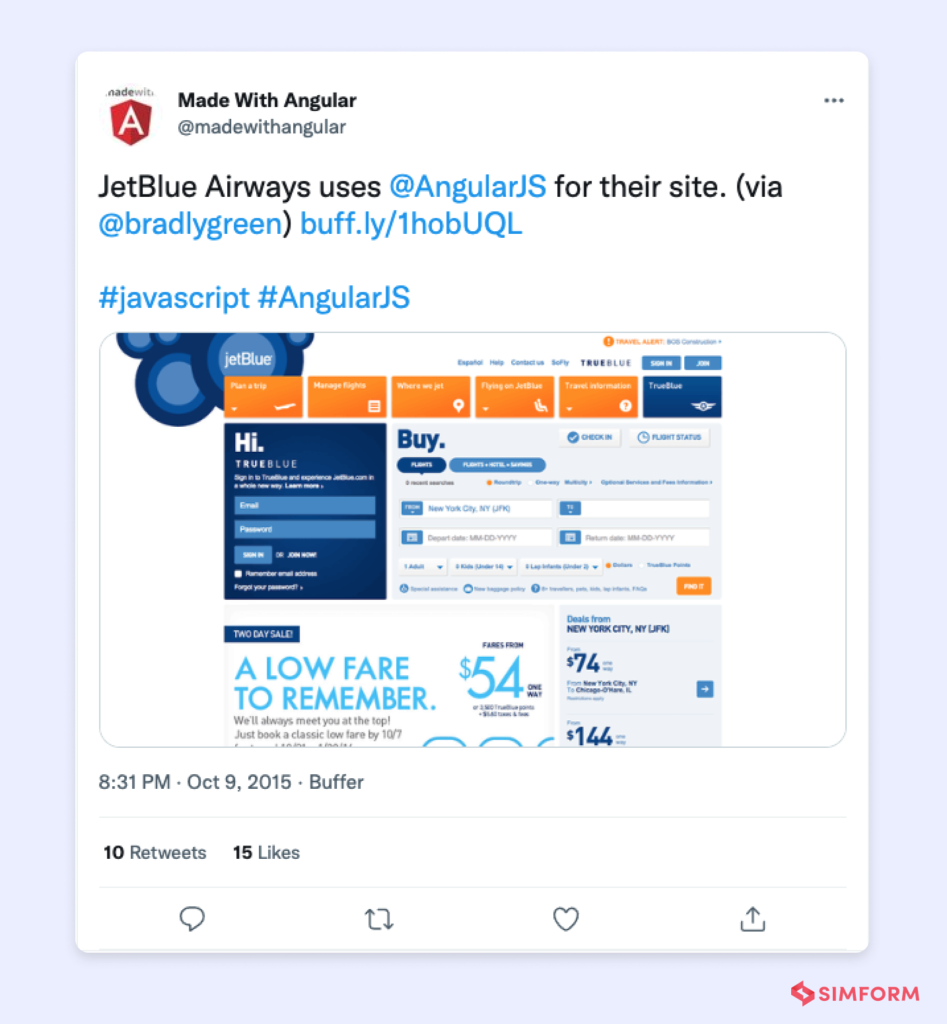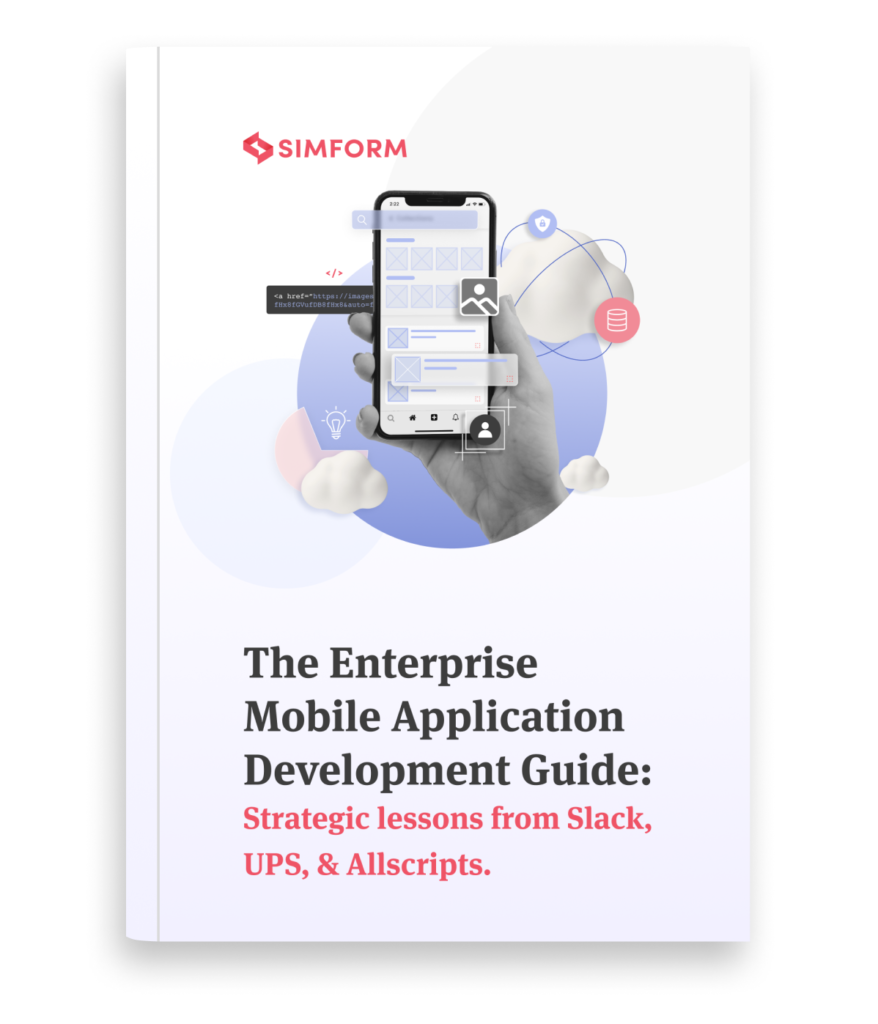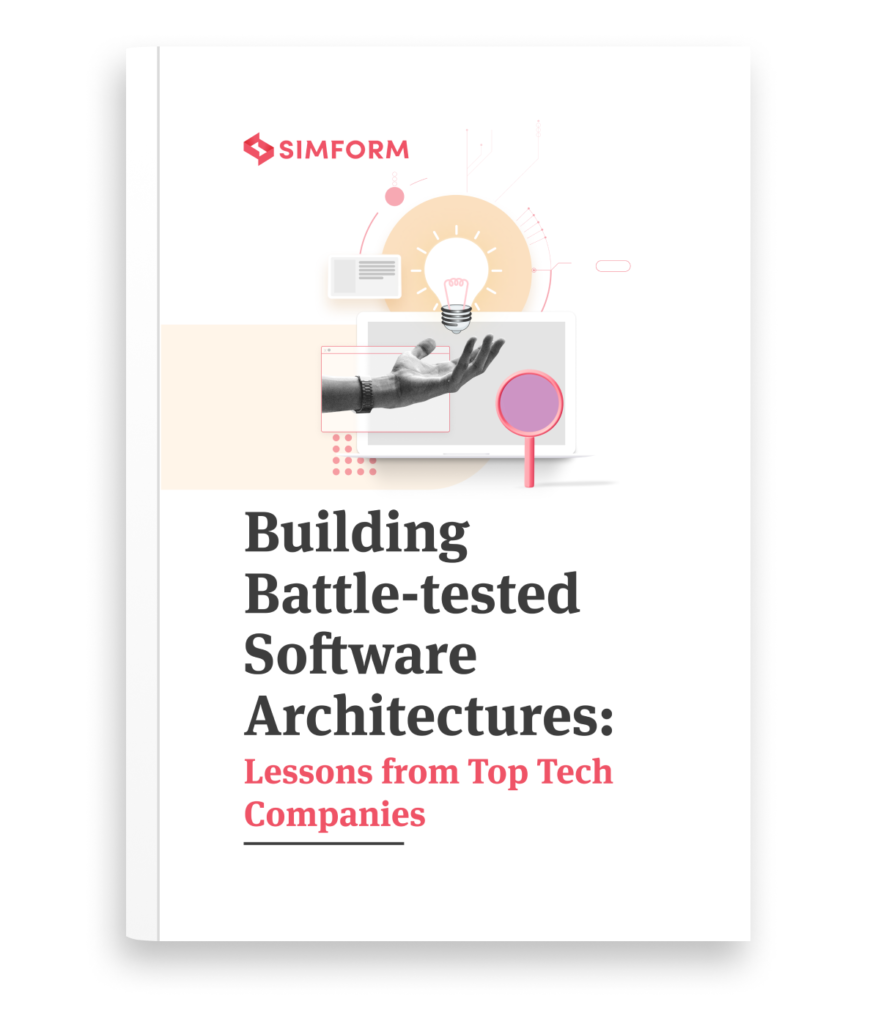The SaaS revolution started with the launch of ReactJS by Facebook in 2015. Even tech giants like Microsoft and IBM have become a part of this burgeoning trend by investing in the development of SaaS frameworks. It’s no secret that SaaS has heavily impacted nearly every aspect of the industrial domain over the past few years, from accounting and banking to customer support and marketing.
Experts have predicted this trend to continue to grow even in the future as the core SaaS elements will provide organizations with better productivity and efficiency. As per PR Newswire, the global market for SaaS-based solutions will reach $307.3 billion by 2026.
Although SaaS has enormous potential to transform business processes, choosing the best SaaS development framework is not a child’s play. This article aims to simplify your decision-making process by compiling the top seven SaaS frameworks.
Top SaaS frameworks: Everything you need to know about them!
The SaaS business framework is superior to the on-premise model as it offers more flexibility, transparency, scalability, and easier integration with third-party applications. However, choosing the best SaaS application framework can be daunting for product managers with a wide range of options available in the market.
Let’s look at them –
1. Symfony
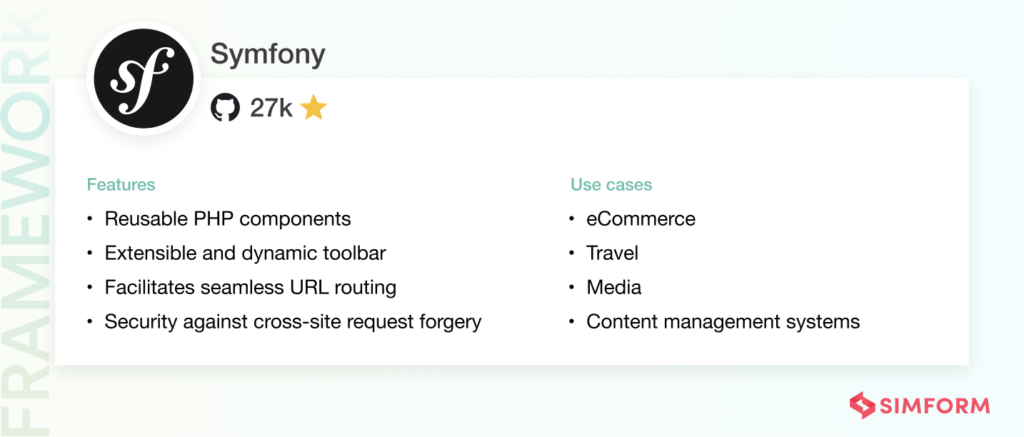
Symfony is a popular open-source PHP framework with 27k stars on GitHub. It has a backing of nearly 6,00,000 situated in 100+ countries and makes the developer’s life easier by offering a structured SaaS architecture, different templates, ORM, multiple libraries, data security, and unity modules.
You can integrate Symfony with an independent library and PHP Unit. Drupal, phpBB, and Composer are some open-source SaaS projects that mainly use the components of Symfony. It also offers clean code, a well-organized structure, and fair programming practices that make web development more effective. Here are some more remarkable features of Symfony –
- Offers reusable and decoupled PHP components
- Provides an extensible and dynamic toolbar that makes debugging easier
- Facilitates seamless URL routing
- Comes with pre-loaded bundles to diversify basic functionalities
- Equips enhanced security to combat cross-site request forgery
Use cases for Symfony framework
1. Media services
Dailymotion has used Symfony to migrate to a new codebase from the existing one to successfully add new features frequently. In addition, Symfony routing flexibly extended the default user behavior to meet its unique needs as and when required.
2. eCommerce
Thelia uses Symfony components like Form, Config, HttpKernel, DependencyInjection, EventDispatcher, etc. HttpKernel provides Thelia with a new way of converting a request into a response, while DependencyInjection centralizes all the objects and facilitates sharing of services among all the application parts.
3. Travel
Symfony has offered Trivago full-stack and micro customization to speed up its development process by using behavioral, functional, and unit testing tools. It also makes it easier for Trivago to integrate new features without configuring the entire framework. Moreover, Trivago has used Symfony to build a full-fledged API in minimal time.
4. Content management system
Jarves is an enterprise-grade Content Management System that is entirely built on Symfony. It uses Proper CRM, RESTful APIs, and a straightforward user interface with a new codebase. Symfony helps Jarves to offer a rich experience to its users.
2. Docker
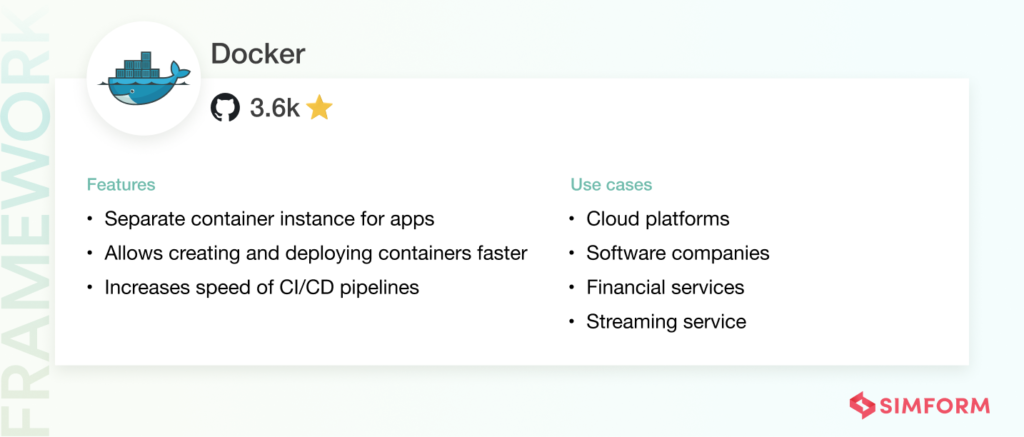
Docker is an open platform that ensures faster shipping, testing, and deploying of codes. As a result, it is the first choice of more than 13 million developers. What’s more, Docker is used to building 7 million+ apps.
Docker enables you to manage infrastructure the same way you manage applications. The great thing about Docker is that you can deploy it on a physical or virtual platform and even on the cloud. In addition, it can significantly reduce the delay between writing code and running the same for production.
What’s more, Docker can help you deploy and scale applications in any environment.
It contains a cross-cloud infrastructure that provides users with an integrated view of all the applications across different environments.
Docker provides some more essential features and benefits to its users –
- Allows running the app over a separate container instance.
- Allows creating and deploying containers at a lightning-fast pace.
- Facilitates running independent tasks to make CI/CD pipelines faster.
Use cases for Docker
1. Cloud platforms
AWS has adopted docker due to its portability in cloud computing. Running Docker on AWS enables developers to effortlessly run containers within cloud-based environments and move apps from one cloud service to another.
2. Software companies
ADP, one of the largest cloud-based human resource solution providers, uses Docker Content Trust to sign images and ensure the same will operate in production. It also performs automated container scanning with multiple Docker Trusted Registries that help companies create a trusted workflow for their apps.
3. Financial services
ING faced issues coordinating changes across its entire structure to the inferior software quality. Therefore, it adopted Docker containers to accelerate provisioning and publishing tests, build servers and automate deployments. As a result, users can seamlessly coordinate on ING.
4. Streaming service
Spotify was facing issues with its CI/CD pipeline. It adopted Docker to ensure that the container passed the build and test process on production. Also, they built a Docker-based platform, Helios to deploy containers across their servers more quickly.
However, Spotify has gradually shifted to Kubernetes to reduce costs and make its offerings more responsive and agile.
3.ReactJs
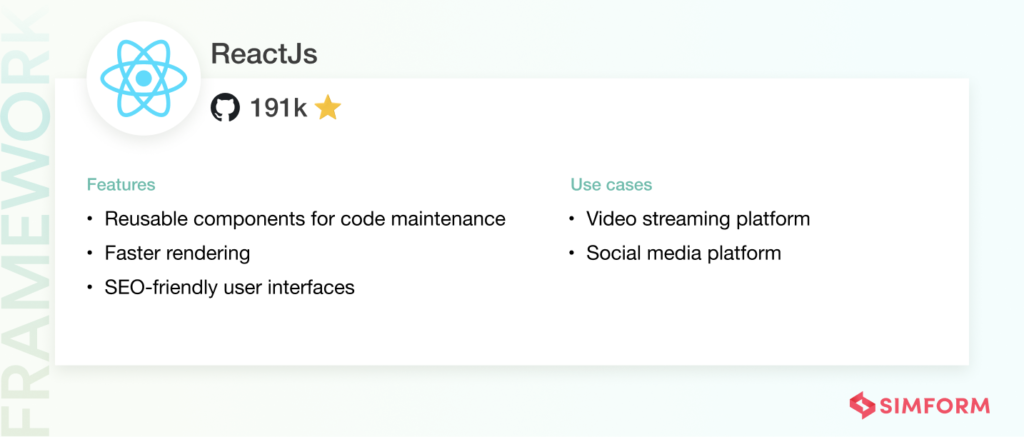
ReactJs is an open-source front-end library for creating better UI/UX design for web and mobile apps. In a 2021 survey, nearly 40.14% of respondents preferred ReactJs for their projects. It makes debugging codes less complicated by dividing them into components.
Other features and benefits of ReactJs include –
- Contains multiple reusable components that help in code maintenance
- Provides faster rendering for better performance
- Facilitates developers to build SEO-friendly user interfaces
- Comes with a supportive toolset for the SaaS development team
- Offers different extensions to support the entire software architecture
How to Effectively Hire and Manage a Remote Team of Reactjs Developers
Use cases for ReactJs
1. Social media platform
Social media giants Instagram and Facebook rely on ReactJs to deliver an exceptional experience to their end-users. Facebook created its beta version by using React Fiber. Similarly, Instagram used React to give an appealing look and feel to its UI and UX.
4. Video streaming platform
Popular OTT platform Netflix used React in 2015 to rewrite the structure of its TV UI entirely. This is because it faced performance issues with TV streaming quality while using Javascript.
ReactJs helped create a rendering layer for web browsers known as Gibbon that they used instead of DOM. Plus, the ReactJS library provided Netflix with multiple benefits like faster startup speed, improved runtime performance, and modularity.
4. Angular
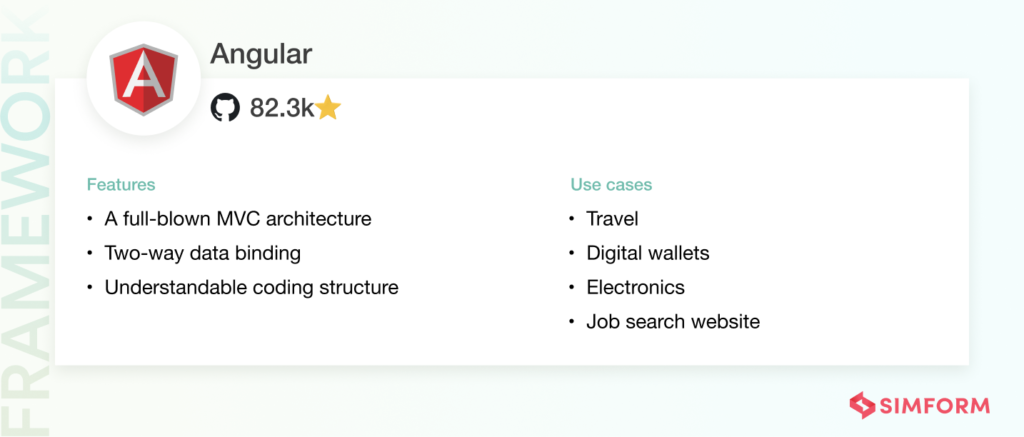
Angular is one of the most-used frontend frameworks. The foremost reason why developers prefer this framework is its ease of use. As per a Stack Overflow’s Developer Survey, Angular is the world’s third most popular web framework. Furthermore, Angular contains a few advanced SaaS development tools like HTML, CSS, Typescript, Karma, Mocha, Visual Studio, etc., that make the entire process effective and program compilation much more accessible.
Other than this, Angular offers some more benefits and features as well. Let’s see them one by one –
- Contains a full-blown MVC architecture and two-way data binding that eliminates intricate programming.
- Offers an understandable coding structure to eliminate bugs and errors quickly.
- Enables developers to create reusable codes that are very accessible.
Angular use cases
1. Travel
Popular American airline service JetBlue harnessed the potential of Angular to handle integrated search functionality and third-party services for car rentals and accommodation bookings. As a result, the company can easily handle the excessive load on its website and deliver an attractive interface to users.
2. Digital wallets
Paypal uses an Angular-based tool, Checkout.js, to offer a seamless checkout experience to its users. Thanks to Checkout.js, users can complete their purchases without leaving the webstore.
3. Job search website
Upwork used Angular to upgrade its website by implementing inherent filtering and navigation capabilities which eventually increased the performance of Upwork’s webpage to a great extent.
4. Electronics
Samsung has built its website for its forward service by using Angular 9+. By implementing Angular, it becomes easier for Samsung to respond to real-time website changes to ensure a better user experience.
5. Laravel
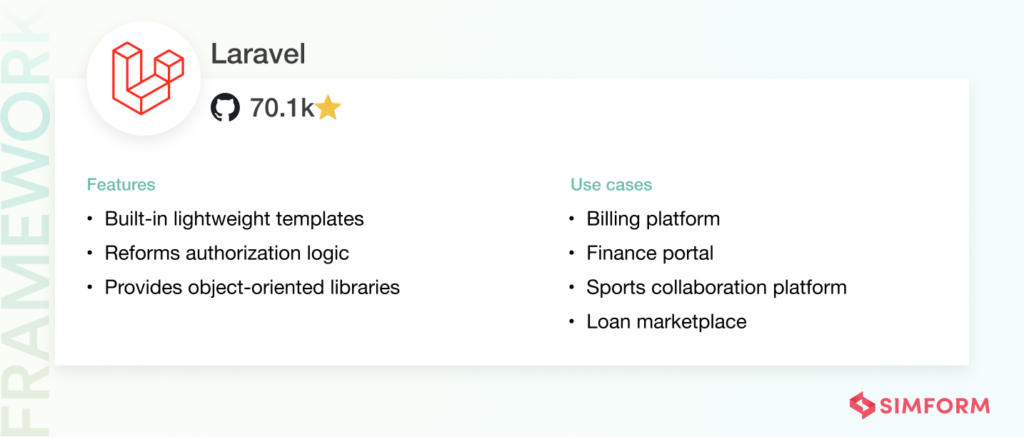
Laravel is a cross-platform PHP framework for building SaaS web apps. It has got 70k stars on Github. There are around 1,40,000+ websites and 98,260 domains built with this framework.
Laravel uses object-relational mapping (ORM) for more straightforward data access and manipulation. It allows developers to use a vast library of pre-programmed functionalities. Moreover, it provides an advanced toolkit to speed up the SaaS development process.
Other than that, there are several other benefits and features offered by the Laravel framework –
- Offers built-in lightweight templates to build layouts with dynamic content seeding
- Reforms authorization logic and controls entry to various resources
- Automates repetitive tasks by using a command-line tool called ‘Artisan.’
- Uses Redis to connect to an existing session and general-purpose cache directly.
- Provides object-oriented libraries
Laravel use cases
1. Finance portal
Headquartered in Chicago, Barchart is a popular finance portal that offers real-time stock market data to users. It has adopted Laravel as its backend framework to ensure that the application remains updated with live data without lag.
2. Sports collaboration platform
Fantasy football is a digital collaboration platform for football events. Thanks to Laravel, it can scale without challenges and automatically loads PHP classes by using auto-loading functionality to make its solution better.
3. Billing platform
Laravel Cashier is a SaaS-based subscription model that is entirely built using the Laravel framework. It helps users to handle boilerplate coding with a built-in subscription billing feature. Laravel Cashier eliminates the complex PHP coding by using the Laravel framework.
4. Loan marketplace
Neighborhood Lender is an online marketplace that helps clients find loans or mortgages in their neighborhoods. It utilizes Laravel to provide built-in cache settings and a mortgage calculator that contains multiple functionalities.
As a result, users do not need to enter their data every time they log in and receive an accurate estimation of their loans.
6. Vue.js
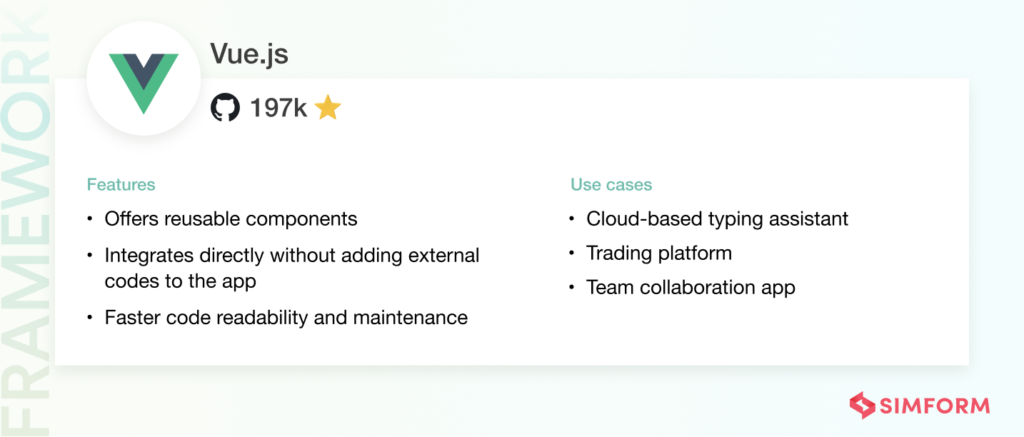
With 197k stars on Github, Vue.js is best known for its creative user interface that is very appealing and suitable for single-view applications. It is used to build over 650k websites Vue.js uses dynamic HTML extensions to facilitate developers in building large-scale web applications.
In addition, Vue.js is a lightweight framework that operates over a command-line interface. It even offers two-way data binding that assists its users in tracking and reviewing real-time updates if any change is made in DOM. Vue.js has attracted many developers because of its Typescript support and extensible design structure.
Here are some more features and benefits of Vue.js –
- Offers reusability of components for building web app templates
- Provides you with a CLI that can ease up the app scaffolding and prototyping
- Integrates directly without adding external codes to the app
- Allows storing each component in a separate file
- Makes code readability and maintenance easier
Vue.js use cases
1. Cloud-based typing assistant
Grammarly is a built-in content editor that uses Vue.js’s template engine syntax and data binding for creating IDE features. It enables Grammarly to get a simplified user interface and attractive layout.
2. Trading platform
Bitpanda is a trading and digital exchange platform mainly used by traders and stock market professionals. It uses Vue.js to add typescript, Vuex, web sockets, REST, etc., to add different components without using CSS.
3. Team collaboration app
Teamhood is a Kanban-based project management and team collaboration tool made in Vue.js. It uses the Vuetify framework to ensure faster speed and efficiency.
7. Django
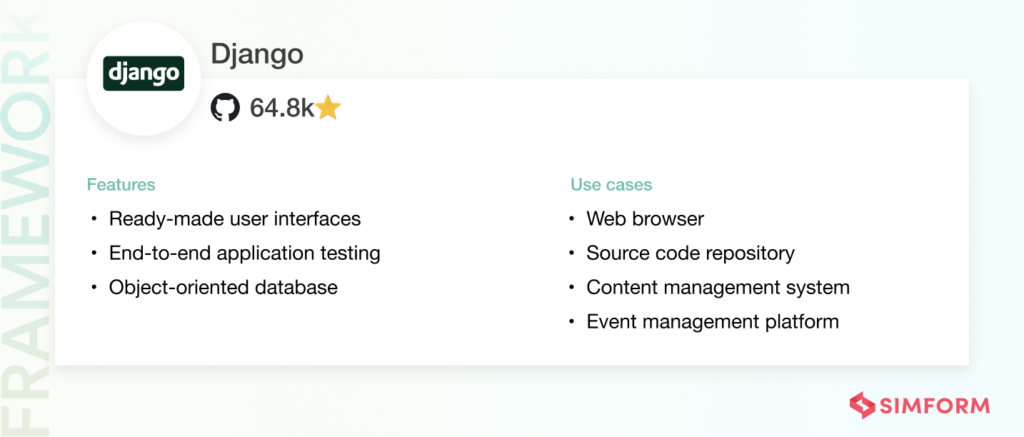
Django is the best-suited framework for creating robust SaaS products that enable a clean and sensible SaaS-enabled product design to encourage faster development. It got a rating of 64.6k stars on Github. More than 80k websites have been built using Django.
Django facilitates developers to stay focused on writing app codes without thinking about web development. It is preferred by 1,00,000+ developers in 2022. Django allows developers to build complex data-driven websites and creates top-notch web and Android apps.
Other benefits and key features of Django include –
- Helps make ready-made user interfaces for better administration.
- Provides supportive authentication protocols by using the REST framework
- Easily documents APIs with an HTML output
- Provides end-to-end application testing for better accuracy
- Secures easier data retrieval with an object-oriented database
Django use cases
1. Web Browser
Mozilla Firefox is a widely used web browser that systematically uses Django to tackle massive site traffic and API hits. Also, Mozilla uses Django-pipeline to manage its static media. As a result, it can deliver a smooth browsing experience to users.
2. Source code repository
Launched in 2008, BitBucket is a hosted provider that makes code collaboration easier for developers while working with version control systems (VCS). Django offered pipelines, reusable code components, abstraction levels, and dynamic layers to Bitbucket to automate operations and ensure a faster turnaround time.
3. Event management platform
Eventbrite is a platform that allows users to find and book virtual events at their fingertips. In 2010, Eventbrite migrated to a vibrant and feature-rich community by embracing Django as its framework. This community made Eventbrite’s bookings faster and easier than before.
4. Content management system
Prezi is a web platform that allows users to create and share interactive presentations with 100 million+ users. To handle such an enormous userbase, its designers have to prototype every single page before the engineering team migrates it to the live production site or adds more features.
To resolve this issue, Prezi used Django CMS to provide fully responsive and dynamic designs to its users. This migration allowed users to autonomously integrate their content.
How to choose the best SaaS framework?
You need to consider factors like cost efficiency, flexible pricing model, personalization, and automation to choose a suitable framework for SaaS solutions. Moreover, analyzing its integration capabilities and ensuring if it aligns with your needs is equally important.
Moreover, you may need to scale up your app or the entire team in the future. So, to choose a suitable SaaS development framework, you must first keep in mind that you will use it for at least five to ten years.
With that foundation, you should consider the following factors before choosing a framework for SaaS development –
Buy or Build?
If you think you can build a cost-effective and faster solution, you should go for it. But if you can’t, you should use a ready-made SaaS solution. Therefore, evaluating the SaaS tech stack options available in the market is advisable before implementing one into your enterprise.
Cloud or On-premise?
Many companies prefer to use the cloud as a SaaS development platform because of its dynamic functionalities. However, some companies prefer developing on-premise SaaS solutions to resolve security issues.
Many options are available across the market if you are considering migrating to cloud architecture for your SaaS model. For example, AWS, Microsoft Azure, Google Cloud, Dell, IBM, etc., are some popular cloud service providers for SaaS-based solutions.
Which database do you need?
To seamlessly handle a considerable amount of data, you need a standard database like SQL and NoSQL. SQL is suitable for SaaS apps that require pre-defined structures and schema. At the same time, NoSQL databases are ideal for apps with large data sets and loosely defined structures.
Which programming language will work best?
Many popular languages include Python, JavaScript, Perl, R, C#, Go, etc., which you can use for your SaaS app development. It would be best to consider your development team’s skill set before making the decision.
Windows or Linux – Which one to choose for deployment?
After choosing the database, programming language, cloud structure, and framework, it’s time to select the platform for deploying your cloud-based SaaS application. Azure will be the most affordable option if you opt for windows. On the other hand, if you opt for Linux, then Javascript and NoSQL are right for you.
Talk to our in-house SaaS experts
Build your SaaS product with Simform!
The global SaaS market is advancing with the latest technologies. Therefore, developing your own unique SaaS product in line with the latest trends is undoubtedly a wise decision. However, it would be best to have constant research and maintenance even after your product launch to secure its market position.
SaaS frameworks offer better flexibility and scalability to enterprises to cope with growing market demands. Also, you can outsource your product updates and development activities to a reputed vendor to focus exclusively on achieving business goals.
If you’re looking for perfect solutions to build your SaaS application, we’re here to help. Our expert development team at Simform can collaborate with you to choose the best framework for your SaaS product. Connect with us today to know more about our services!
